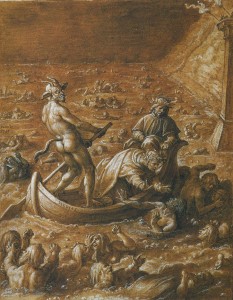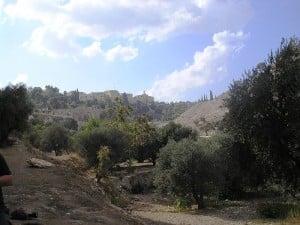Jerry Shepherd offers his second rebuttal to Chris Date’s argument for the annihilation view of hell. Jerry focuses on the apocalyptic language of the book of Revelation and the statements that refer to the wicked being tormented forever.
This is my third post in this very enjoyable exchange. In the previous ones, I went beyond our agreed-upon word limits, so, in fairness to my brother Chris, I am going to curb the length of this rebuttal,

and rather than responding to everything in his last post, I am going to focus on just one key area.
According to Rev 14:9-11, those who worship the beast and his image (notice: not the beast or the image, but the ones who worship the beast and his image; i.e., human beings) will be “tormented with burning sulfur.” The “smoke of their torment will rise for ever and ever.” “There will be no rest day or night” for these human beings.
According to Rev 20:10-15 the devil is thrown into the lake of fire, a lake into which the beast and the false prophet had been thrown earlier (Rev 19:20). We are then told that human beings, whose names were not found written in the book of life, were cast into that same lake of fire, which is the second death.
The book of Revelation is an apocalyptic document, and shares many characteristics with other apocalyptic works of the Second Temple period: mediated revelation; narrow, and to a certain extent, other-worldly or other age-ly eschatology; an oppressionistic context; a very pronounced dualist ethical differentiation; and, of course, unusual, even bizarre, imagery. However, the book also purports to be a “revelation from Jesus Christ,” a revelation that “God gave him,” and one which he was to communicate “to his servants.” While, on the one hand, the imagery of the book needs to be acknowledged as such, and an attempt made to interpret that imagery sensibly and carefully, I argue here that it is illegitimate to play the “imagery” card to negate the relevance of these passages for the contribution they make to the question of ECT versus conditionalism.
In this regard, then, it is particularly important to notice what happens in the juxtaposed scenes in chapters 20 and 21-22:
Chapter 20 uses fantastic imagery: the abyss, a key and a great chain, a dragon/serpent and a beast, fire from heaven, a lake of fire, burning sulfur. And we are told in the chapter that the wicked who are thrown into that lake, whose names are not written in the book of life, are tormented forever. Parallel to chapter 20, chapters 21-22 also use fantastic imagery: a cube-shaped city floating down from heaven, a bride dressed for her husband, walls of jasper, foundations made of jewels, gates made of single pearls, streets of gold, a multi-fruited tree. And we are told in the chapter that for the righteous who live in this city, whose names are written in the book of life, there will be no more death; they will reign for ever and ever.
So here is my question. Are there any conditionalists who would like to argue that, because chapters 21-22 use such fantastic imagery, their statements that the righteous will live forever and ever must be discounted or relativized, and that they make no real contribution to our understanding of eternal life for the redeemed? By the same token, I deny that the fantastic imagery of chapter 19 discounts or relativizes the duration statements of chapter 20 (as well as that of chapter 14), and that they make no real contribution to our understanding of eternal torment for those who are not redeemed. And the phrase, “second death” does not negate the force of these statements; rather, these statements inform us to what the second death means.
Which of the following “forever” statements in the book of Revelation are negated by the book’s fantastic imagery?
“To him be glory and power for ever and ever” (1:6; aiōnas tōn aiōnōn).
“I am the Living One; I was dead, and now look, I am alive for ever and ever!” (1:18; aiōnas tōn aiōnōn).
“Whenever the living creatures give glory, honor and thanks to him who sits on the throne and who lives for ever and ever, the twenty-four elders fall down before him who sits on the throne and worship him who lives for ever and ever” (4:9-10; aiōnas tōn aiōnōn, 2x).
“To him who sits on the throne and to the Lamb be praise and honor and glory and power, for ever and ever!” (5:13; aiōnas tōn aiōnōn).
“Amen! Praise and glory and wisdom and thanks and honor and power and strength be to our God for ever and ever” (7:12; aiōnas tōn aiōnōn).
“And he swore by him who lives for ever and ever” (10:6; aiōnas tōn aiōnōn).
“The kingdom of the world has become the kingdom of our Lord and of his Messiah, and he will reign for ever and ever” (11:15; aiōnas tōn aiōnōn).
“Then one of the four living creatures gave to the seven angels seven golden bowls filled with the wrath of God, who lives for ever and ever” (15:7; aiōnas tōn aiōnōn).
“And they [the saints] will reign for ever and ever” (22:5; aiōnas tōn aiōnōn).
Then neither does that imagery negate these forever statements in the book:
“And the smoke of their torment will rise for ever and ever. There will be no rest day or night for those who worship the beast and its image, or for anyone who receives the mark of its name” (14:11; aiōnas tōn aiōnōn; cf. 19:3).
“They will be tormented day and night for ever and ever” (20:10; aiōnas tōn aiōnōn).
So even though these statements occur in a book which is, admittedly, very much characterized by imagery, it does not follow that they must give way to statements that occur in more “didactic” literature. Yes, there is a principle that the supposedly less clear statements in Scripture are to be interpreted in the light of the more clear ones. But, as I tell my hermenenutics students, sometimes, perhaps the supposedly less clear statements are there to alert us to the possibility that perhaps we are misinterpreting the ones that we think are more clear.











